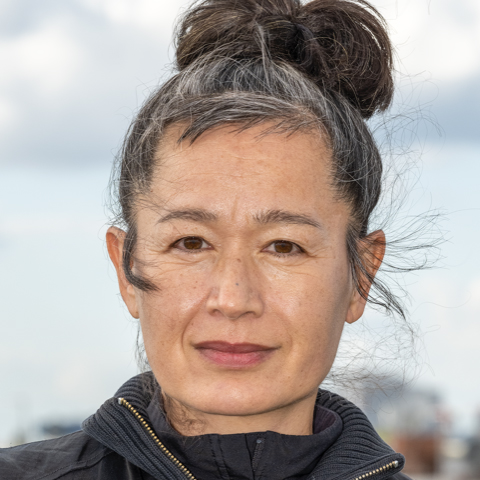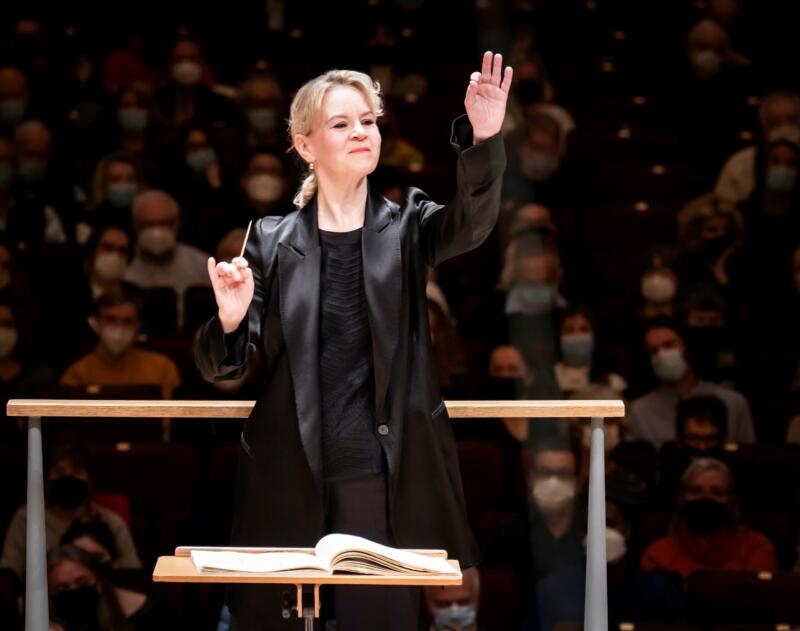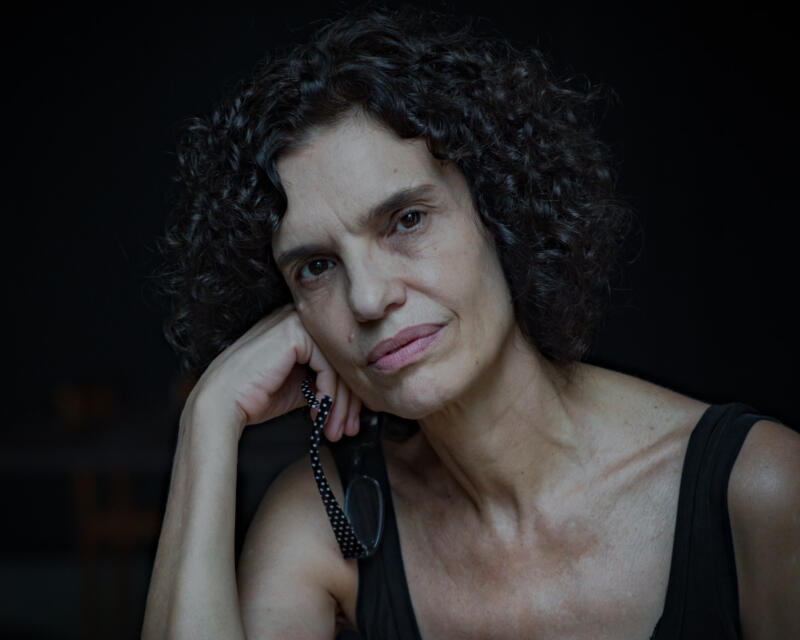Honorary doctor Hito Steyerl: Outside the box
Hito Steyerl has been listed as one of the most influential people in contemporary art. The experimental artist herself is unsure how to comprehend these external categories. She is one of the recipients of honorary doctorates at Uniarts Helsinki.

“I am not one of those genius people working in the middle of the night,” says Berlin-based filmmaker, moving image artist and writer Hito Steyerl, pulling a quiet smirk.
“My brain shuts down in the late afternoon, so I need to schedule my days if I want to get any work done.”
Steyerl notes that when given the chance, most people prefer not to work and that she is one of them.
She has no romantic illusions regarding her craft, even though it is an interesting one: Steyerl is known for her work, for example, criticising technocracy and exploring digitalisation with the means of installations, photography and video.
She has also written essays about images and sounds that create new relationships to objects, become objects themselves and produce other objects and images.
Currently Steyerl works as a professor of experimental film and video and is the co-founder of the Research Center for Proxy Politics at the Berlin University of the Arts.
“Besides teaching, I am experimenting with artificial intelligence, writing a book and preparing new works dealing with technology.”
Making a statement
In August 2024, Steyerl will receive an honorary doctorate from the University of Arts Helsinki, where she worked as a guest professor at the Academy of Fine Arts from 2012 to 2014. She says the recognition makes her genuinely happy.
“I’m happy this distinction comes from the university I enjoyed working in. I also love the opportunity to revisit Helsinki.”
Steyerl has not always been keen on accepting honours. In 2021, she was offered one of the most prestigious civilian honours in Germany, the Federal Cross of Merit, but she turned it down.
“Germany had pandemic issues, which, of course, most countries had at the time. In my opinion, they were not handled very well here.”
Steyerl wrote an open letter published in Die Zeit, a German weekly magazine. In the letter, she criticised the German government’s policies during the lockdown, favouring the commercial field while exhausting the fields of culture and education. This is the reason that led her to reject the Federal Cross.
“I simply wanted to make a statement,” she says casually.
From absorbing to experimenting
Steyerl was born and raised in Bavaria. The region is known for its architectural and natural beauty, but as a community, Steyerl, half-Japanese and half-German, found it authoritarian, conservative and very racist.
“Not a very pleasant place to grow up in the 70’s”, she sums up.
Steyerl’s interest in cinema was sparked at a very young age. She went to movies avidly, spending a lot of time in front of the silver screen, not analysing, not trying to learn anything, just enjoying her time.
“Well, I mean, there was no internet, no laptops, and definitely no YouTube”, she says.
“If you wanted to be entertained, you had to go to movies since there was nothing else.”
At the age of 15, Steyerl joined a group of West German anarchists, which led to her being expelled from school after squatting in a building with the group.
Steyerl says this was the first time she encountered government surveillance, a theme she has also been dealing with extensively in her work.
“We were just kids, but I guess the government took us very seriously,” Steyerl laughs.
“The officials were following us, and my phone was tapped. Of course, I can’t prove any of this, but that was how things were back then.”
Since she was no longer studying, Steyerl had a lot of free time, which she then turned into creating. She started filming her own material using her Super 8 film camera. The films were experimental and often shot without any particular intention.
“Filming was very connective. I had a lot of other people around me”, Steyerl says.
Steyerl’s creative ideas grew from having fun with friends to being more ambitious. After a few years, it turned out that the previous high school dismissal had actually been a fortunate one.
“Shohei Imamura, founder of the Japanese Institute of Moving Image, had a distinct policy of accepting people kicked out of schools.”
Art of destroying joints
Steyerl moved to Japan to study filmmaking under Imamura’s guidance. She says she learned many important lessons there, such as how to deal with substantial cultural differences.
In addition to filmmaking, another activity took up much of her time.
“I had practiced Korean martial arts already in Munich, and in Japan, I turned to Shotokan-karate. I liked it a lot and spent up to five hours a day in the studio”, Steyerl says.
“I find it a comprehensive form of art that teaches you to focus your mind and encounter challenges, but it’s also really bad for your joints! At least mine are destroyed.”
Steyerl finished her degree in 1990. She stayed in Japan and had the opportunity to work as an assistant to Wim Wenders in the production of Until the End of the World. The filming took place in eleven countries.
“It was great for me,” Steyerl recalls.
“The film was kind of a monster – in an interesting way – but we travelled all over the world, and there were technical parts that were very interesting. Sony labs were just developing HD technology, and Wenders was tinkering about that. It was fascinating to follow the experimental use of this technology.”
Steyerl says there have been hundreds of people during her life who have inspired and affected her work.
“But to name one, I say Harun Farocki.”
Farocki was a German filmmaker, writer, internationally celebrated contemporary artist and professor who, in his works, investigated, for example, the forms of intelligence between text and image. Steyerl collaborated with him and sees Farocki as her mentor.
“He was a colleague more than a generation older, but a huge inspiration to me.”
Widespread burnout of technology
Steyerl has also studied at the Academy of Fine Arts in Vienna and holds a degree in philosophy. She sees philosophy as a supporting element to her filmmaking.
“For example, when I was studying documentary filmmaking, my thesis was documenting ideas of truth, which holds a philosophical angle,” she says.
For Steyerl, there are many big questions for which answers are sought through art. One of them is the effect of technology on everyday life.
“The pace of technological development has been breathtaking. The entire communications infrastructure has changed, and not for the better”, she says.
She has been especially interested in the relationship between humans and image. Steyerl has been pondering whether people are hidden by too many images or becoming images themselves.
“People are transforming into digital versions of themselves, even attempting to bring online pictures into reality by trying to perfect their appearance to match what is seen online.”
Though critical, Steyerl is not completely anti-tech. She sees fast data computation as a positive thing, contributing to insights into process tasks and recognising patterns, which could be helpful, for example, in the medical field.
“But I think one should also consider other things to make progress for society.”
Steyerl says she is seeing a slight exhaustion developing, a “widespread burnout of technology,” as she puts it, as the digital world is wild and ever-changing.
“There is a lot of information blending into a cacophony of news, which cannot be trusted by default. Technological development also means that we must constantly learn new things”, she says.
“People feel out of control as everything is changing all the time. This results in them returning to poetry or haptic things, like weaving.”
Influence not within parameters
An international contemporary art magazine, ArtReview, named Steyerl the most influential person in the field of art in 2017. Last year, she was number two on this list. Steyerl herself sees this kind of ranking as unimportant.
“I’m not sure how to even comprehend these external categories. It is like a parallel quantum reality. Maybe some people live in that reality, but I’m not a part of that.”
To her, influence is in no way a parameter to measure.
“Influencing can happen in unexpected ways,” she reminds.
“One individual artist can affect another one, resulting in a web of connections. There cannot be a measurable criterion for this.”
Text: Jouni Kantola
Uniarts Helsinki conferment event, the ceremonial conclusion of university studies, will be held in Helsinki from 16 to 18 August 2024. The ceremony will feature the conferment of degrees on master’s graduates and doctors from the university’s academies. Additionally, honorary doctorates will be conferred on eight individuals who represent Finnish or international pioneers and influential figures in their fields and who have advocated for arts education or advanced the societal role and significance of the arts.
The honorary doctors have been selected by the boards of the Academy of Fine Arts, Sibelius Academy and Theatre Academy and the board of the University of the Arts Helsinki. Being conferred an honorary doctorate is the highest recognition bestowed by the university.



